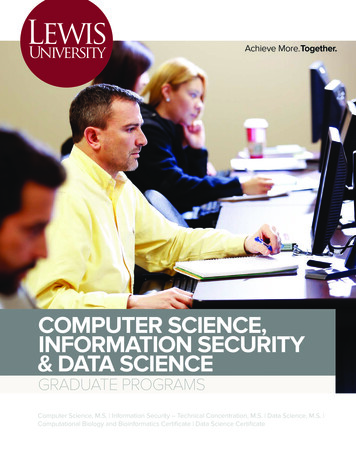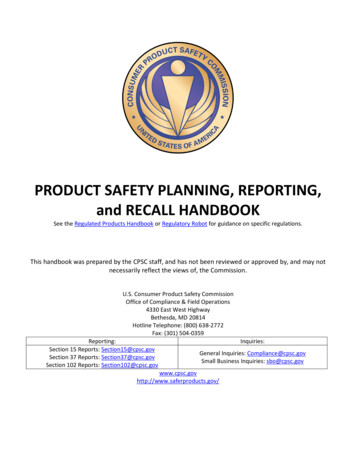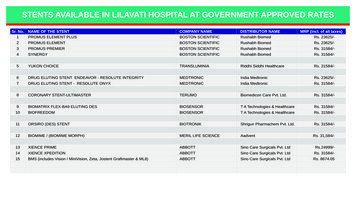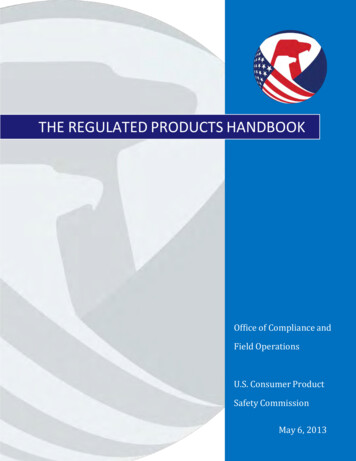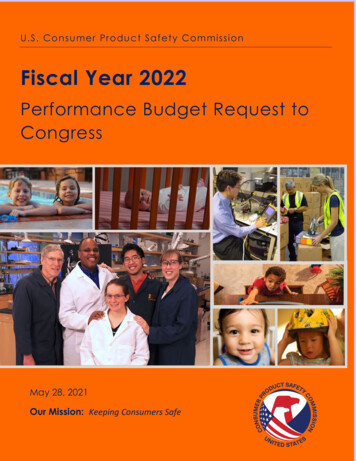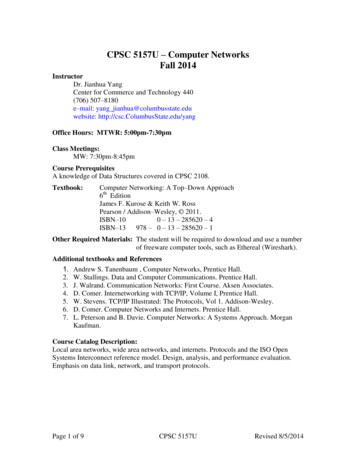
Transcription
CPSC 5157U – Computer NetworksFall 2014InstructorDr. Jianhua YangCenter for Commerce and Technology 440(706) 507–8180e–mail: yang jianhua@columbusstate.eduwebsite: http://csc.ColumbusState.edu/yangOffice Hours: MTWR: 5:00pm-7:30pmClass Meetings:MW: 7:30pm-8:45pmCourse PrerequisitesA knowledge of Data Structures covered in CPSC 2108.Textbook:Computer Networking: A Top–Down Approach6th EditionJames F. Kurose & Keith W. RossPearson / Addison–Wesley, 2011.ISBN–100 – 13 – 285620 – 4ISBN–13 978 – 0 – 13 – 285620 – 1Other Required Materials: The student will be required to download and use a numberof freeware computer tools, such as Ethereal (Wireshark).Additional textbooks and References1. Andrew S. Tanenbaum , Computer Networks, Prentice Hall.2. W. Stallings. Data and Computer Communications. Prentice Hall.3. J. Walrand. Communication Networks: First Course. Aksen Associates.4. D. Comer. Internetworking with TCP/IP, Volume I, Prentice Hall.5. W. Stevens. TCP/IP Illustrated: The Protocols, Vol 1. Addison-Wesley.6. D. Comer. Computer Networks and Internets. Prentice Hall.7. L. Peterson and B. Davie. Computer Networks: A Systems Approach. MorganKaufman.Course Catalog Description:Local area networks, wide area networks, and internets. Protocols and the ISO OpenSystems Interconnect reference model. Design, analysis, and performance evaluation.Emphasis on data link, network, and transport protocols.Page 1 of 9CPSC 5157URevised 8/5/2014
CPSC 5157U – Computer NetworksUndergraduate OfferingCourse DescriptionThis course is a broad introduction to networking concepts and emphasizes the following:1. Local area networks, wide area networks, and internets.2. Protocols and the OSI (Open Systems Interconnect) reference model.3. Design, analysis, and performance evaluation.Course Topics1. The large–scale structure of the global Internet and its associated protocols;2. The OSI Reference Model and the Internet Protocol Stack;3. The Application Layer: Structure and sample applications;4. The Transport Layer: Its function and services;5. Reliable data transport and congestion control;6. The uses of UDP and TCP; the trade–offs between them;7. The Network Layer: Its function and services;8. The structure of IP addresses: classful and classless addresses;9. The DNS (Domain Name Service): “User friendly” names & IP addresses;10. Routing on the Internet;11. The Link Layer: Its function and services;12. Error detection and correction techniques;13. Collision detection and the Ethernet solution to that problem;14. Collision avoidance and the Token Ring solution to that problem;15. Link–layer switches: forwarding and filtering;Learning Objectives1.2.3.4.Become familiar with layered communication architectures (OSI and TCP/IP).Understand the client/server model and key application layer protocols.Learn sockets programming and how to implement client/server programs.Understand the concepts of reliable data transfer and how TCP implements theseconcepts.5. Know the principles of congestion control and trade-offs in fairness andefficiency.6. Learn the principles of routing and the semantics and syntax of IP.7. Understand the basics of error detection including parity, checksums, and CRC.8. Know the key protocols for multimedia networking including IntServ andDiffServ for IP.9. Familiarize the student with current topics such as security, network management,sensor networks, and/or other topics.10. Increase the ability to write a report to a project or a hand-on exercise and make apresentation.Learning OutcomesUpon successful completion of the courses in this discipline, the student will:Page 2 of 9CPSC 5157URevised 8/5/2014
CPSC 5157U – Computer NetworksUndergraduate Offering1. Demonstrate oral and written communication skills and increase ability to beeffective team members. Strategies:o Study of current research topics in computer networko Use Wireshark hands-on exercise report writing and presentationo Write team project report and make a presentationo Summarize research paper in computer network and make apresentationABET Criteria: A, B, C, F, I, and JCS Program Objectives: 2, 3, and 4Assessment: Project, hands-exercise report writing, research paper summary,oral presentation.2. Demonstrate the basic knowledge of intranet, internet, and the Internet. Strategies:o Study chapter 1 of the textbooko Conduct hands-on exercise to design a and set up a local area networko Exercise tools to explore intranet and the Internet infrastructureABET Criteria: A, B, and CCS Program Objectives: 2, 3Assessment: Written assignment, Hands-on lab report, quiz, and networkonline tools practicing report3. Demonstrate the knowledge of computer network programming, such as socketprogramming. Strategies:o Study chapter 2, and 3 of the textbooko Conduct hands-on socket programming on TCP and UDPo Exercise Wireshark hands-on labABET Criteria: A, B, C, I and JCS Program Objectives: 2, 3Assessment: Programming assignment, Programming Project, Hands-on labs4. Demonstrate the understanding of internet model, or OSI model and the TCP/IPprotocol suit. Strategies:o Study chapter 2, 3, 4, 5o Use Wireshark hands-on labso Learn network online toolso Conduct computer network projectso Read some TCP/IP related research papersPage 3 of 9CPSC 5157URevised 8/5/2014
CPSC 5157U – Computer Networks Undergraduate Offeringo Read protocol-related RFC filesABET Criteria: A, B, C, E, I, J, and KCS Program Objectives: 2, 3Assessment: Writing assignment, project, exam, hands-on labs5. Demonstrate the ability to apply computer network knowledge to solving a realworld application. Strategies:o Study one of two of chapter 6, 7, 8, 9 of the textbooko Conduct a comprehensive projecto Conduct a short term internship if possibleo Conduct a field trip to local IT company, campus IT centerABET Criteria: A, B, C, D, E, F, I, J, and KCS Program Objectives: 1, 2, 3, 4Assessment: Project report, presentation, internship report, or field trip report.Course Methods1. The class will be a lecture course, taught face to face.2. Laboratory experiences will be part of the course.3. Students will be expected to complete hands-on exercises and a series ofprogramming assignments.Student Responsibilities1. Attend class regularly (if so enrolled) and participate in all class discussions.2. Complete all reading assignments and all homework assignments.3. Ask the instructor questions.4. Send the instructor e–mail with both comments and questions.Instructor Responsibilities1. Give lectures on the course material.2. Assign appropriate homework that illustrates the concepts of the course, andgrade and return the homework in a timely manner with adequate explanation.3. Give tests over the material and grade and return the tests in a timely manner4. Provide a website that supports the course.5. Provide at least four hours of office time primarily designated for assistance ofstudents in this class, at times expected to be convenient for the students. It isexpected that the instructor be available to the students during these hours.6. Reply promptly (within one business day) to all student e–mail communications.Methods for Evaluating StudentsThe evaluation methods will include homework and a comprehensive final exam. Inaddition there is a “class participation” component to the grade.AssignmentsHands-on labsProgramming ProjectPage 4 of 920%10%10%CPSC 5157URevised 8/5/2014
CPSC 5157U – Computer NetworksClass QuizMid-Term ExamFinal Exam10%20%30%Undergraduate OfferingWhen scheduled by the University Registrar.The Exams: All exams will be given in class. They may be either open–book orclosed–book, depending on the context. The time allocated will be the standard.The Mid–Term Exam will be an one–hour exam.The Final Exam will be a two–hour exam.Assignment of Letter GradesThe method of assigning letter grades based on overall course averages is fairly standard.The basic method for assigning grades is described as follows:Average90 – 10080 – 8970 – 7960-69Below 60Page 5 of 9Letter GradeABCDFCPSC 5157URevised 8/5/2014
CPSC 5157U – Computer NetworksUndergraduate OfferingTentative Topic ScheduleWeek 0/2210/2710/2911/311/5Page 6 of 9Topics to be coveredIntroduction to the classThe Internet and network edgeThe Network CoreDelay, Jitter, Loss, &ThroughputProtocol LayersHistoryLabor Day, no classCh Asgn LabNetwork ApplicationsThe Client / Server ModelThe Web and HTTPFile Transfer: FTPElectronic Mail: SMTPThe Domain Name ServicePeer–To–Peer ApplicationsIntroduction to TCP and UDPSocket Programming with TCPSocket Programming with UDPEnd–to–end vs. host–to–hostTransport layer vs. NetworkLayerConnectionless Transport: UDPReliable Data TransferConnection–Oriented Transport:TCPReliable Data TransferFlow and Congestion ControlConnection ManagementThe TCP “Handshakes”Midterm reviewMidtermFall break, no classgo through the Midterm2Forwarding and RoutingReal circuits vs. virtual circuits.Routers and SwitchesFormat of an IP packetIP version 4 address formatClassful and classless addressesCIDR (Classless Interdomain4CPSC 5157UQuiz1112A1Quiz 1Lab 12Quiz 2223A2Quiz 333Quiz 43Lab 2A3Quiz 544444Revised 8/5/2014
CPSC 5157U – Computer 12/3Undergraduate OfferingRouting)IP version 6Routing algorithmsMore on DNSDHCP (Dynamic HostConfiguration)NAT (Network AddressTranslation)Link Layer and Network LayerLink layer servicesError Detection and ErrorCorrectionManaging a Shared ChannelThe Ethernet and the AlohanetLink Layer AddressingThanksgiving. No classEthernet AddressingCSMA/CDEthernet vs. Token Ring45A4Lab 3Quiz 655A5555Quiz 7Course AssistanceStudent assistants in the Computer Center can help you with basic computer–relatedproblems (such as logging on to the network, saving your work, etc.), but they are nottrained to help you with your assignments. We have several tutors at the Department ofComputer Science who can help you with programming assignments. Their schedule isposted at the department office. You can always contact me during the posted officehours or by appointment. The best way to get in touch with me is by e–mail atyang jianhua@columbusstate.edu.Dropping the CourseWe hope that you will complete the course and profit from it. If it is necessary for you towithdraw from the course during the semester, you must follow all official CSUprocedures for withdrawing. It is not sufficient to notify the instructor; you must use theISIS system and withdraw officially. For details on how to withdraw from a course, seethe web hdrawal%20from%20a%20Course.I would appreciate it if you were first to consult with me before starting the procedure forwithdrawing from the course. In some cases, we can agree on an arrangement that willallow you to complete the course with minor adjustments.Academic HonestyAcademic dishonesty includes, but is not limited to, activities such as cheating andplagiarism ic Dishonesty/AcademicMisconduct). It is a basis for disciplinary action. Any work turned in for individual creditmust be entirely the work of the student submitting the work. All work must be your own.Page 7 of 9CPSC 5157URevised 8/5/2014
CPSC 5157U – Computer NetworksUndergraduate OfferingYou may share ideas but submitting identical assignments (for example) will beconsidered cheating. You may discuss the material in the course and help one anotherwith debugging; however, any work you hand in for a grade must be your own. A simpleway to avoid inadvertent plagiarism is to talk about the assignments, but don't read eachother's work or write solutions together unless otherwise directed. For your ownprotection, keep scratch paper and old versions of assignments to establish ownership,until after the assignment has been graded and returned to you. If you have any questionsabout this, please see me immediately. For assignments, access to notes, the coursetextbooks, books and other publications is allowed. All work that is not your own,MUST be properly cited. This includes any material found on the Internet. Stealing orgiving or receiving any code, diagrams, drawings, text or designs from another person(CSU or non-CSU, including the Internet) is not allowed. Having access to anotherperson's work on the computer system or giving access to your work to another person isnot allowed. It is your responsibility to keep your work confidential.No cheating in any form will be tolerated. Penalties for academic dishonesty may includea zero grade on the assignment or exam/quiz, a failing grade for the course, suspensionfrom the Computer Science program, and dismissal from the program. All instances ofcheating will be documented in writing with a copy placed in the Department's files.Students will be expected to discuss the academic misconduct with the faculty memberand the chairperson. For more details see the Faculty ndbook0203/sec100.htm#109.14 and theStudent Handbook: pdfADA Accommodation NoticeIf you have a documented disability as described by the Americans with Disabilities Act(ADA) and the Rehabilitation Act of 1973, Section 504, you may be eligible to receiveaccommodations to assist in programmatic and/or physical accessibility. We recommendthat you contact the Office of Disability Services located in Schuster Student SuccessCenter, room 221, 706-507-8755 as soon as possible. The Office of Disability Servicescan assist you in formulating a reasonable accommodation plan and in providing support.Course requirements will not be waived but accommodations may be able to assist you tomeet the requirements. Technical support may also be available to meet your specificneed. Course requirements will not be waived, but reasonable accommodations may beprovided as appropriate. It is then your responsibility to contact and meet with theinstructor. It is also your responsibility to present the instructor with a letter fromthe Center for Academic Support. Without this letter detailing the requiredaccommodations, the instructor cannot help you. The Center for Academic Supportcan assist you and the instructor in formulating a reasonable accommodation plan andprovide support in developing appropriate accommodations for your disability. Courserequirements will not be waived but accommodations may be made to assist you to meetthe requirements. Technical support may also be available to meet your specific need.For more information on services and support available, refer tohttp://uc.columbusstate.edu/disability services.htm.ABET Criteria:Page 8 of 9CPSC 5157URevised 8/5/2014
CPSC 5157U – Computer NetworksUndergraduate OfferingA. An ability to apply knowledge of computing and mathematics appropriate to thediscipline;B. An ability to analyze a problem, and identify and define the computing requirementsappropriate to its solution;C. An ability to design, implement and evaluate a computer-based system, process,component, or program to meet desired needs;D. An ability to function effectively on teams to accomplish a common goal;E. An understanding of professional, ethical, legal, security, and social issues andresponsibilities;F. An ability to communicate effectively with a range of audiences;G. An ability to analyze the local and global impact of computing on individuals,organizations and society;H. Recognition of the need for, and an ability to engage in, continuing professionaldevelopment;I. An ability to use current techniques, skills, and tools necessary for computing practice.J. An ability to apply mathematical foundations, algorithmic principles, and computerscience theory in the modeling and design of computer-based systems in a way thatdemonstrates comprehension of the tradeoffs involved in design choices;K. An ability to apply design and development principles in the construction of softwaresystems of varying complexity.CS Program Objectives:Our graduates will have achieved:1) a broad general education assuring an adequate foundation in science and mathematicsrelevant to computing.2) a solid understanding of concepts fundamental to the discipline of computer science.3) good analytic, design, and implementation skills required to formulate and solvecomputing problems.4) the ability to function and communicate effectively as ethically and social responsiblecomputer science professionals.Page 9 of 9CPSC 5157URevised 8/5/2014
12 11/3 Classful and classless addresses 4 11/5 CIDR (Classless Interdomain 4 . CPSC 5157U - Computer Networks Undergraduate Offering . Link Layer Addressing 5 11/26 Thanksgiving. No class 16 12/1 Ethernet Addressing CSMA/CD 5 12/3 Ethernet vs. Token Ring 5 Quiz 7 Course Assistance Student assistants in the Computer Center can help you with .
